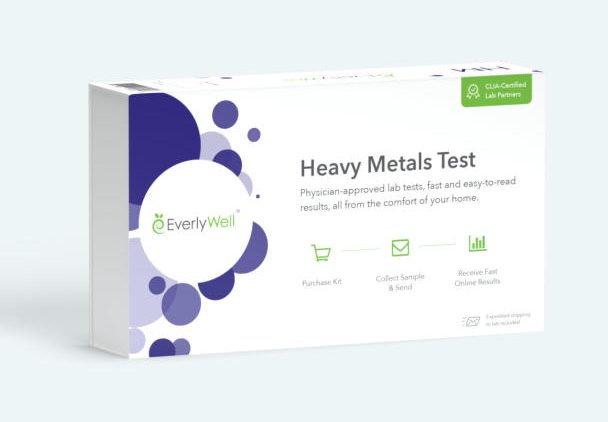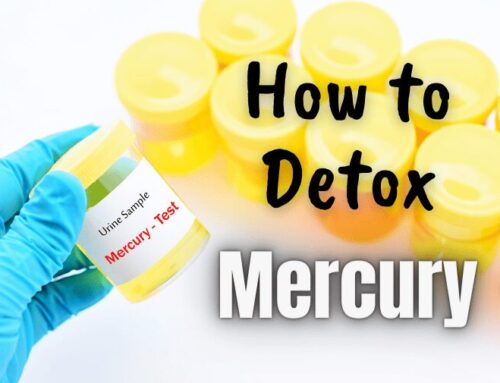Sick of Being Stuck is reader-supported. When you buy through links on my site, I may earn a commission. Disclosure.

If you’re over-exposed, or unable to cleanse properly, you’re at risk for heavy metal accumulation. Sadly, you may not even think that you are affected by heavy metal toxicity, but it is something we are ALL dealing with because heavy metals are everywhere.
Don’t believe me? Then take an at-home test today to see what heavy metals are at a toxic level in your system today!
What is Toxicity from Heavy Metals?
There is an important distinction between the levels of heavy metals in the blood and how they affect the body.
- Poisoning: You can get acute poisoning from heavy metals by ingesting a lot all at once. For example, this may happen if a child swallows a toy made with lead. Symptoms are clear and come on fast and maybe confusion, numbness, vomiting, or passing out. Acute poisoning is an emergency situation and any individual with metal poisoning should be taken to the hospital immediately.
- Toxicity: This is the degree to which the heavy metal is present and/or harmful.
- Accumulation: The slow buildup of heavy metals over time. This is a process that takes years because the body doesn’t ever eliminate metals on its own, accumulation happens naturally. The only way to prevent accumulation is to prevent heavy metals in the first place.
What Are the Side Effects of Heavy Metal Toxicity?
These dangerous heavy metals actually “intrude” and interrupt normal cellular processes. Heavy metals can bind with protein sites and replace the metals that naturally occur in the cell with toxic levels.
Some experts attribute the primary driver of all diseases today to heavy metals. We’re seeing health issues and diseases at rates we didn’t see 30 years ago, because of the increase of these toxins into our environment. This has also lead to an increased need for heavy metal detox.
Heavy Metal Toxicity Symptoms – Long Term Exposure
Heavy metal toxicity can seriously impact the body. At best, they cause lower energy levels and fatigue. At worst, heavy metal damage affects the proper functioning of the brain, lungs, kidney, liver, blood composition, and other important organs.
According to a 2014 article in the journal Interdisciplinary Toxicology, long-term exposure can lead to gradually progressing physical, muscular, and neurological degenerative processes that imitate diseases such as multiple sclerosis, Parkinson’s disease, Alzheimer’s disease, muscular dystrophy, and maybe even cancer.
How Do I Know Which Toxic Heavy Metals are in My Body?
Since heavy metals can accumulate in two different ways, it can be hard to pinpoint the way in which you developed heavy metal toxicity. Unless you had an acute poisoning, one high dose of metals, then we will have to assume you may have chronic poisoning. Chronic poisoning is a low dose over time, which most of us have experienced.
The best recommendation is to take a test to know exactly which heavy metals are in your system. This at-home heavy metal toxicity test is a good way to see if any of the toxic heavy metals are present in your system.
What Are Toxic Metals?
LEAD:
Lead is a toxic metal, even in small quantities.
Sources: Lead is often found in automobiles, paints, hair dyes, PVC pipes, and most commonly in the corrosion of household plumbing systems. Smelters and pesticides also emit lead.
Lead Toxicity Effects:
- Physical or mental development delays in children
- Kidney problems and high blood pressure in adults
- Shortage of memory and can even deplete the IQ level
- A decrease in sperm production and increased chances of miscarriage
ARSENIC:
Rat poison? Yep, same stuff.
Sources: Arsenic was once used to coat wood to keep it from rotting. That practice ended in 2002, but it is still used in the manufacturing of glass, semiconductors, paints, dyes, drugs, soaps, and pesticides, which is one of the main ways it enters our water system through runoff. It’s even found in small traces in beer (kill me now!)
Arsenic Toxicity Effects:
- Arsenic produces neurological problems, especially in children
- Arsenic causes cancer, specifically skin and lung cancer
- It can cause circulatory system damage and affects the peripheral nervous system
MERCURY:
Mercury is found in traces in the air, but when it gets into water, it mixes with natural bacteria and converts to methylmercury which is toxic.
Sources: Oil refineries, coal-burning plants, runoff from landfills, erosion of natural deposits, combustion of diesel, and medical wastes, are common sources of mercury.
Mercury Toxicity Effects:
- It can cause brain damage, blindness, and deafness
- It may lead to digestive problems and kidney damage
- It can affect the mental development of a developing fetus in pregnant women
Don’t forget, a big source of mercury you may not be realizing is your mercury amalgam fillings! But don’t worry, you can remove them safely!
CADMIUM
It is another dangerous heavy metal that finds its way to the human body.
Sources: Found in the corrosion of galvanized pipes, metal refineries, runoff from waste batteries and paints, sewage discharge, and mining operations.
Cadmium Toxicity Effects:
- Serious damage to the kidneys, liver, and bones
- Results in kidney disease, brittle bones, and in some cases death
THALLIUM
Thallium is a soft, malleable gray metal naturally found in the Earth’s crust but is also highly toxic. It is odorless, colorless, and tasteless.
Sources: Rat poison, insecticides, cigarette smoke, medical imaging.
Thallium Toxicity Effects:
- Nausea, vomiting, and diarrhea
- May cause serious nervous system damage that may cause loss of reflexes, convulsions, muscle wasting, headaches, numbness, dementia, psychosis, and even coma
- It can cause hair loss (alopecia)
ALUMINUM
Aluminum is the most plentiful metal in the earth’s crust. It is also present in the environment and while exposure to aluminum is usually not harmful, high levels can cause serious health problems.
Sources: Found in the air, food, water, and soil. Exposure is almost inevitable, but high levels may come from drink or ingest substances containing high levels of aluminum, aluminum dust in workplace air, aluminum mines, or hazardous waste.
Aluminum Toxicity Effects:
- Confusion, seizures, or speech problems
- Muscle weakness, bone pain, fractures, and deformities
URANIUM
Uranium is a naturally occurring element that is radioactive.
Sources: Found in very small amounts in rocks, soil, surface and underground water, air, and plants and animals. Toxicity effects found most commonly in mine, industrial, or underground workers.
Uranium Toxicity Effects:
- Also known as radiation sickness and starts with nausea and vomiting
- Depending on the level of exposure, may also cause headache, fever, dizziness, fatigue, hair loss, infection, low blood pressure
COPPER
One of the few metals that can occur in nature in a directly usable metallic form very high thermal and electrical conductivity and used naturally in the human body.
Sources: Copper is found mostly in our diet, sometimes in copper piping, copper cooking materials, or copper IUDs in women.
Copper Toxicity Effects:
- Copper can have a profound effect on mental and emotional conditions including depression, anxiety, violence, OCD, bipolar disorder, phobias, Tourette’s syndrome, schizophrenia, epilepsy, ADD, ADHD, autism, delayed mental or emotional development, panic attacks, migraines, spaciness, brain fog, mind racing, insomnia, nervousness, and irritability.
- Reproductive Disorders specifically for women.
- Connective tissue problems including arthritis, osteoporosis, stretch marks, joint problems, scoliosis, kyphosis (bad posture), poor skin, hair, and nail conditions.
- A sluggish liver due to copper toxicity causes slow metabolism, chronic infections, and hepatitis C.
Harmful Metals
Some heavy metals that cause toxicity occur naturally in the body, like copper. Metals in the body become toxic when they accumulate to unhealthy levels, this is when we define it as heavy metal toxicity.
However, some metals are not good for the body in any amount. They are not meant to be digested or used for human consumption at all. When present in the human body, these metals can cause irreparable damage.
A heavy metal detox is the best way to remove these metals if they become present through outside sources.
|
|
Toxic Heavy Metal FAQs
- Where Do Heavy Metals Come From?
Most heavy metals are naturally occurring and exist almost everywhere in the world around us.
Exposure to heavy metals comes from traffic fumes, air pollution, water contaminants, radiation, dental fillings, poor-quality diet, household products, and chemicals in everyday products.
- What is the difference between acute poisoning and chronic poisoning?
Acute poisoning is when you experience one high dose of metals, like if you don’t use the right dentist when you have your mercury amalgam fillings removed safely. Whereas chronic poisoning is a low, but consistent dose over time that causes symptoms that are harder to detect. This is why I suggest getting a test done to know if you have been exposed to heavy metal toxicity.
- What is the best test to determine if you have heavy metal toxicity?
Your primary care physician can have you take a test, or you can order your own test to take at home with just a urine sample. I recommend using this heavy metals test if you are ready to know what’s going on inside your body!
Ready to Detox?
A heavy metal detox helps the body to naturally eliminate these toxins from our internal organs. There are many things that can add up in our daily lives that can actually hurt us if we don’t take the time to assess our health.
Heavy metal toxicity is something that can affect anyone of us and it is our job alone to correct that. Modern medicine doesn’t always view heavy metals as an issue, but unfortunately, it can cause problems down the road if not addressed now. The best way to avoid heavy metal toxicity is to recognize the source and staying away from it.
Ready to heal yourself from heavy metal toxicity? Then check out my detox guide and don’t forget to take your heavy metals test first!








Leave A Comment